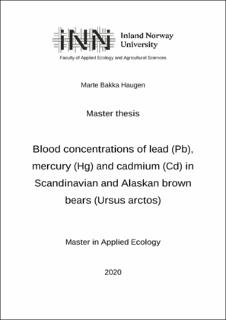Blood concentrations of lead (Pb), mercury (Hg) and cadmium (Cd) in Scandinavian and Alaskan brown bears (Ursus arctos)
Master thesis

Åpne
Permanent lenke
https://hdl.handle.net/11250/2660562Utgivelsesdato
2020Metadata
Vis full innførselSamlinger
Sammendrag
Lead (Pb), mercury (Hg) and cadmium (Cd) are among the most serious environmental heavy metal pollutants with long half-life times that will make them present in both the environment and living organisms over a long period of time. They are found naturally in all ecosystems but the exposure is often due to human activities. Both humans and animals are exposed to these through ingestion or inhalation. With this bakground I will in this study test differences in the bear blood concentrations among brown bears (Ursus arctos) in Scandinavia and Alaskan National Parks. The measurements of the bears in Alaska are taken in Lake Clark, Gates of the Arctic and Katmai. In general, the results shows a trend in differences depending on the heavy metal in relation to the study area. The results revealed elevated blood Pb concentrations among the sampled brown bears from Scandinavia compared to Alaska. On the other hand, they also revealed significantly low blood Hg concentrations among Scandinavian brown bears compared to Alaskan brown bears. For blood Cd concentrations there was less clear differences among the study areas. Bears in Gates of the Arctic and Scandinavia had higher blood Cd concentrations than in Katmai and Lake Clark. Overall, we see that the differences in the heavy metal concentrations of the brown bears in this study are due to location. Studied locations differed in primary food resources and aerial heavy metal depositions mainly human caused, but also natural occurences. The exposure of heavy metals can also be due to both new and old emissions as they have accumulation capacity both in the environment and in animal body tissues. A study like this can provide opportunities for further research where the actual results can be seen in the context of other analyzes of blood concentrations of heavy metals.